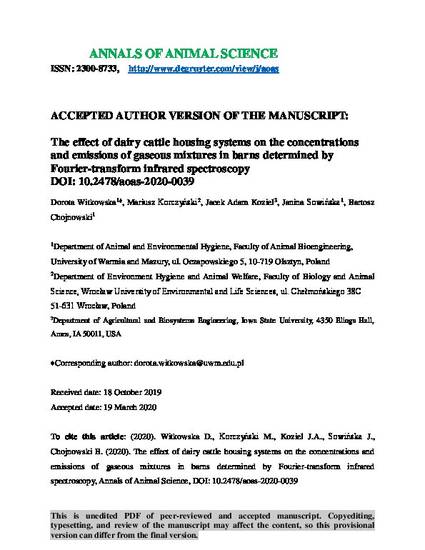
The aim of this study was to determine the concentrations and emissions of greenhouse and odorous gases in different types of dairy cattle housing systems with the use of Fourier-transform infrared (FTIR) spectroscopy. The study was performed in autumn and winter in four types of dairy cattle barns with different process and technical systems (free-stall, deep litter – FS-DL; free-stall, sub-floor manure storage – FS-SFM; free-stall, litter in stalls – FS-LS; tie-stall, litter in stalls – TS-LS) in northern Poland. Analyses of gaseous mixtures in barn air were conducted by infrared spectrometry with the multi-component Gasmet DX4030 analyzer. A total of 200 measurement spectra were acquired and subjected to qualitative and quantitative analyses with the Calcmet Professional program with a library of reference spectra for 200 chemical compounds. The results of the study indicate that housing systems and the technological solutions applied in barns exert a considerable influence on the production of greenhouse and odorous gases. Free-stall housing with slatted floors and sub-floor manure storage appears to be the optimal solution for reducing the animals’ exposure to the presence of the analyzed chemical compounds in air, improving animal welfare and minimizing GHG emissions to the environment (considering the optimal ventilation rate). It should be noted that the concentrations of other potentially harmful compounds, for which the maximum safe levels have been specified, were also relatively low in the remaining systems, which points to the observance of high sanitary standards and the use of efficient ventilation systems in the evaluated barns.
Available at: http://works.bepress.com/jacek_koziel/344/

This article is published as Witkowska D., Korczyński M., Koziel J.A., Sowińska J., Chojnowski B. "The Effect of Dairy Cattle Housing Systems on the Concentrations and Emissions of Gaseous Mixtures in Barns Determined by Fourier-Transform Infrared Spectroscopy." Annals of Animal Science 20, no. 4 (2020): 1487–1507. DOI: 10.2478/aoas-2020-0039. Posted with permission.